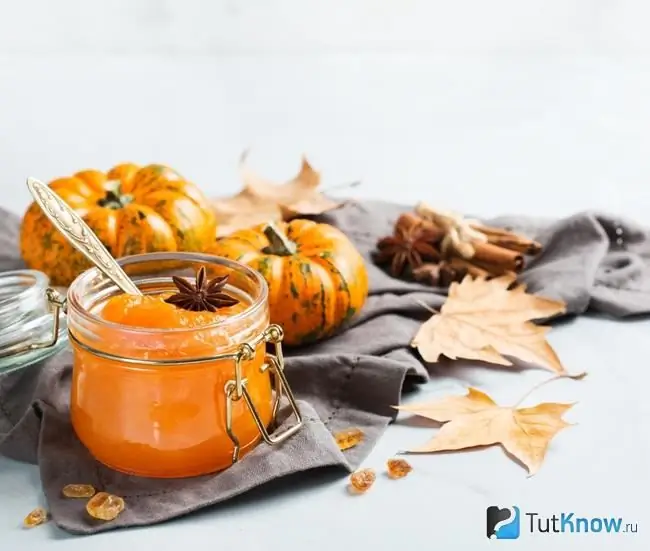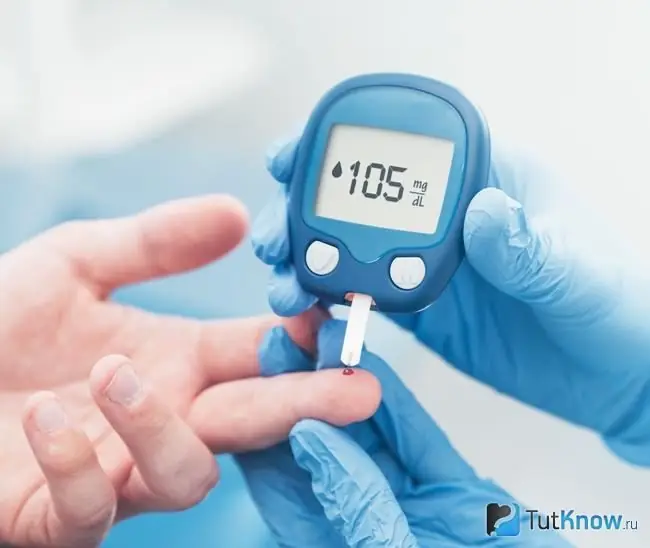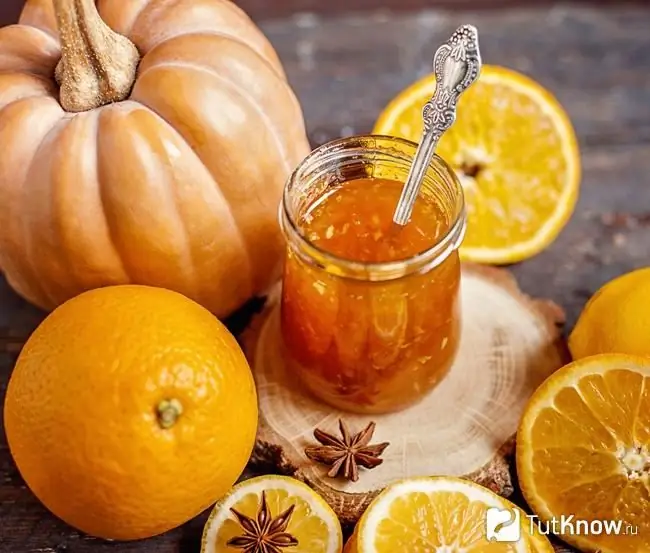Composition and calorie content of pumpkin jam. Useful properties and harm. Pumpkin jam recipes, interesting facts.
Pumpkin jam is not only tasty, but also a healthy treat containing a number of vitamins and minerals. Exotic soft taste with citrus aroma (if they are included in the recipe) will appeal to many sweet tooths. But including a new dish in the diet, you should study its composition, as well as the correct recipe and cooking technology. Violation of the canning conditions will not allow you to enjoy pumpkin jam with orange or lemon and can discourage the desire for culinary experiments.
Composition and calorie content of pumpkin jam

Pictured pumpkin jam
Pumpkin as a fruit of a food plant has a mild, but not very bright taste. Therefore, pumpkin jam recipes, in addition to the caramelizing ingredient, include other components for tint aromas. Accordingly, the composition and energy value of the dish may differ depending on the additional ingredients.
The most popular are recipes with citrus fruits (lemon, orange). The average calorie content of such a dish is 140 kcal or 586 kJ.
Despite the moderate calorie content for a dessert, when calculating the diet, it should be borne in mind that the nutritional value of pumpkin jam with lemon or orange is shifted towards carbohydrates.
BJU dessert per 100 g is:
- Proteins - 0.7 g;
- Fat - 0.1 g;
- Carbohydrates - 32.7 g.
The calorie content of pumpkin jam is not the only important indicator, because many useful vitamins and minerals remain in the cooking process.
Vitamins per 100 g:
- Vitamin A - 147.8 mcg;
- Beta-carotene - 0.887 mg;
- Thiamin (B1) - 0.033 mg;
- Riboflavin (B2) - 0.038 mg;
- Pantothenic acid (B5) - 0.257 mg;
- Pyridoxine (B6) - 0.082 mg;
- Folate (B9) - 8, 676 mcg;
- Ascorbic acid (C) - 10 mg;
- Alpha tocopherol (E) - 0.253 mg;
- Vitamin H - 0.17 mcg;
- Vitamin PP - 0, 4382 mg.
Minerals per 100 g:
- Potassium - 138, 35 mg;
- Calcium - 21, 04 mg;
- Magnesium - 9.34 mg;
- Sodium - 4, 83 mg;
- Phosphorus - 15.8 mg;
- Chlorine - 10, 89 mg;
- Iron - 0, 361 mg;
- Iodine - 0.77 mcg;
- Cobalt - 0, 643 mcg;
- Manganese - 0.027 mg;
- Copper - 114, 48 mcg;
- Molybdenum - 0.052 mcg;
- Fluorine - 75, 97 mcg;
- Zinc - 0.1561 mg.
The key components of pumpkin jam are indicators of vitamin A, beta-carotene, copper. The level of elements per 100 g of the product reaches 15% of the daily intake. And even despite the relatively low content of elements such as vitamin H, sodium, chlorine, iodine, molybdenum (up to 1%), their natural origin guarantees their complete assimilation, which means that the maximum benefit of such consumption. Synthetic analogs do not possess similar properties of complete assimilation.
Note! The amount of vitamin C varies greatly depending on the recipe and in some cases reaches 11-15% of the daily intake, which makes pumpkin jam for the winter an ideal addition to a balanced daily diet.
Useful properties of pumpkin jam

Pumpkin is a classic autumn vegetable and is healthy raw due to its vital elements. After heat treatment, the quantitative composition of such nutrients decreases slightly, but still remains at a fairly high level.
It is noted that the systematic use of pumpkin jam with dried apricots or other additional elements affects the following body systems:
- Nervous … Carotene (and its in 100 g of the product is up to 15% of the daily value) strengthens not only vision, but also takes an active part in the formation of the sheath of nerve fibers. In pumpkin jam with lemon, the recipe for which may be the simplest, carotene is 5 times more than in carrots, and starch and cholesterol are completely absent. The support of the nervous system with carotene leads to an increase in resistance under stress conditions.
- Immune … Vitamin C has immunostimulating and tonic properties, and thanks to a special heat treatment technology, recipes for pumpkin jam with oranges or lemons allow you to keep a large amount of ascorbic acid in the dish.
- Digestive … Even after thoroughly chopping pumpkin for jam through a meat grinder and heat treatment, up to 1.4 g of dietary fiber remains in the dessert, which is 7% of the daily norm. Adequate fiber stimulates the gastrointestinal tract.
- Cardiovascular … The combination of potassium and magnesium in the product helps to remove excess fluid from the body and, as a result, reduce the load on blood vessels. Potassium in particular also improves the conduction of cardiac impulses. And if you cook pumpkin jam with dried apricots, the amount of potassium in the product increases significantly.
- Excretory … The system is stimulated due to its complex composition. Dietary fiber, by adsorbing metabolic products in the intestines, stimulates the elimination of toxins from the body. Excess fluid is also removed.
It should be understood that just a simple pumpkin jam is not enough to compose a rational and healthy menu, but if you want sweets, then choose just this one - healthy and tasty. The best time to consume dessert is, of course, the winter-spring period. When a person suffers from seasonal vitamin deficiency, the body needs vitamin support.
In addition, pumpkin jam is good for:
- Normalization of digestion in case of constipation - fresh pumpkin in large quantities has a pronounced laxative effect, and in conservation, this effect is present in a mild form.
- Improving performance during active mental stress and to tone up the state after physical activity - preference should be given to recipes with an additional content of vitamin C (pumpkin jam with apples, lemons, oranges).
- Reducing age-related changes - carotene in pumpkin promotes collagen production and eliminates skin laxity. And although it will not be possible to stop the aging process with the help of only one product, the systematic consumption of carotene and related vitamins helps to slow down such changes.
For those who decide to skip the consumption of meat, the benefits of pumpkin jam are also in the protein content. 100 g of the product can contain up to 1 g of protein, and if pumpkin seeds are present in the recipe, this figure increases to 16 g.
Note! Technically, pumpkin is the berry of the plant. However, in cooking for garnish fruits it is customary to use the designation "vegetable".
Contraindications and harm to pumpkin jam

Pumpkin jam is not the last in the list of healthy desserts. And it is not surprising, because the unique composition of canned sweetness is absorbed easily and quickly. However, there is also harm from pumpkin jam, which all sweet lovers should know about.
The cells of the pumpkin contain proteins of profilins and reserves, which in some cases cause allergies. It is noteworthy that such proteins are resistant to the acidic environment of the digestive system, as well as to thermal effects. Once in the intestines of people sensitive to profilin, they cause a corresponding reaction. In isolated cases, in addition to skin rashes and itching, attacks of anaphylaxis were noted.
When wondering how to cook pumpkin jam, one should also not be fooled by the exceptional benefits of the base ingredient, jam is still a sweet preservation. This product is not recommended:
- people suffering from urolithiasis;
- with disorders of the gastrointestinal tract (low acidity, acute gastrointestinal diseases);
- diabetics.
Pregnant women should use pumpkin jam with caution.
In addition to the main ingredient, it should not be overlooked that frozen or fresh pumpkin jam contains other components that have an effect on the human body. It is clear that recipes with oranges and lemons in the composition are not suitable for people who are sensitive to ascorbic acid, but you should also pay attention to spices, to which there may also be an increased sensitivity.
Important! Pumpkin profiles have a cumulative effect. That is, with an increase in this substance in the human intestine, an allergic reaction may occur not only to pumpkin, but also to other products (melon, citrus fruits, peaches, nectarines).
Pumpkin Jam Recipes

In most cases, pumpkin jam is recommended to be consumed "bite" with coffee or tea. The delicacy is served in rosettes or spread directly on bars, toasts, rolls. However, experienced chefs recommend diversifying the table not only with a new recipe for how to make pumpkin jam, but also with an interesting serving.
Large pieces of candied pumpkin will decorate the dessert table. If you have a special pastry spoon, then you can form balls from the jam by placing them inside the jelly or as a decoration for a fruit salad.
Jam can also be used as a filling for shortbread cookies, pie. Additional cooking will not diminish the benefits of the pumpkin jam.
The best time to consume a sweet product is considered the first half of the day. With the right diet, a small amount of sugar sweetness will not hurt even with strict control of dietary habits. And if we talk about seasonality, then winter and early spring, of course, are the perfect time for tasting. In some cases, fortified jam is stretched until May, then moving on to fresh vegetables and fruits with no less nutritional and vitamin reserves.
The procedure for making pumpkin jam step by step:
- Select ingredients and prepare them for seaming - rinse, cut.
- Prepare the recipe for syrup or jam.
- Sterilize cans and seaming lids.
- Close conservation.
Before making pumpkin jam, you need to choose the right ingredients. For a recipe with caramelized pieces of vegetable, you need to choose dense fruits with a thin peel, you can pay attention to slightly unripe pumpkins. When choosing a product on the market, inspect the stalk; a suitable specimen should be firm and elastic. If the stem is rotten, look for another fruit. But for jam textures, ripe and slightly overripe fruits are suitable. The color of the pumpkin can vary from light green to rich orange, depending on the plant variety, ripening stage, collection.
Other components of the jam should also be carefully selected. Oranges and lemons should be medium in size with a thin skin, free from damage or pressure sores.
After choosing vegetables and fruits, they must be washed and dried. The pumpkin is grown on the ground, the particles of which remain on the skin for a long time. If you ignore thorough rinsing, the taste of the jam can be spoiled.
Sterilization of cans at home is carried out both dry and wet. In the first case, glass containers are placed on medium power in the microwave for 30 seconds or more, and in the second, the jars are sterilized over steam. If you choose steam sterilization, then dry the glass before pouring the finished jam so that excess moisture does not spoil the taste of the preservation. The lids are easiest to sterilize in hot water. To do this, leave them in boiling water for a few minutes.
Pumpkin Jam Recipes:
- Classical … For 0.5 kg of peeled pumpkin, you will need 500 g of sugar and 150 ml of water. At the preparation stage, the vegetable is cut into small cubes, and syrup is made from water and sugar. It is considered ready when it flows in a thin monolithic stream from a wooden stirrer. Only then can pumpkin cubes be added to the mass. The further cooking process will depend on the density of the vegetable. The jam, ready to pour, should be uniform, amber in color. From the moment the mass acquires this color, it must be boiled for another 3 minutes, and then poured into cans for further seaming. The classic recipe can be easily supplemented with spices at will, for this, in the last 3 minutes of cooking, we add the desired modifier, for example, pumpkin jam with ginger or vanilla sugar will taste significantly different from the traditional sweetness.
- With citrus … For one serving of the preparation, you will need 1.5 kg of diced pumpkin, 1 medium-sized lemon and 1 orange, 1 kg of sugar. Citrus fruits must be cut into thin slices, while removing all the seeds. The ingredients are thoroughly mixed in a saucepan and left overnight to let the orange, lemon and pumpkin juice out. The next day, the mixture must be brought to a boil and, stirring, boil for 5 minutes. Then the mass is removed from the fire and cooled. This cooking procedure is repeated two more times. Ready jam is rolled into jars.
- With lemon and ginger … 1 kg of finely chopped ripe pumpkin, pour 1 kg of sugar, leave the mixture overnight for the pumpkin to juice. The next day, chop 1 lemon and 1 ginger root in a blender and add to the pumpkin mixture. For a light ginger aroma, a small root 3 cm long is enough, and for the pumpkin jam with lemon and ginger to turn out to be spicy, choose a root of 5-7 cm. Bring the sugar mixture to a boil, and then, reducing the heat, cook for another 40 minutes, stirring constantly. The finished mass can be rolled up immediately or previously wiped through a sieve to make a sweet puree.
- With apples … Such a recipe will require more time from you than a simple pumpkin jam with orange or lemon, but the original unique apple flavor will delight you. For 1 kg of pumpkin, you need to take 1 kg of apples and only 5-6 tbsp. tablespoons of sugar. The pumpkin and apples must be cooked in separate pans. 3 tablespoons are added to the vegetable. sugar, and to apples, depending on their acidity - 3-4 tbsp. The mixture with sugar must be cooked over low heat until the pumpkin and apples are softened. Only then can the two purees be mixed and whipped until smooth. This mixture is boiled for another 5-6 minutes, and only then the applesauce is canned.
- In a multicooker … This pumpkin jam recipe is interesting not only for its taste, but also for its simple cooking technology. 0.5 kg of pumpkin pulp must be finely diced and covered with 600 g of sugar. The mixture should be infused for at least 6 hours for the pumpkin to let the juice flow. After that, add 1 teaspoon of citric acid, mix everything well and put in a slow cooker on the "cooking" mode for 1 hour. Stir the mixture regularly in the multicooker bowl. The syrup of such a jam turns out to be transparent, and the pumpkin cubes are dense in texture.
As you can see, making pumpkin jam does not take much time, while the finished dish is obtained with an interesting rich taste and moderate calorie content. After trying classic recipes, you can experiment with the composition, adding spices to taste, honey syrup or other fruits to the preservation.
Note! Frozen pumpkin will make the jam soft. If you have such a product, pick up a jam recipe.
Interesting facts about pumpkin jam

The oldest pumpkin seeds were found on the territory of modern Mexico, their age is more than 7000 years. A nutritious and at the same time easy-to-grow plant quickly conquered Europe and Asia, and the fruits themselves began to be used not only for food, but also for household items. So, in Asia, jugs and plates, traps for monkeys were made from pumpkin peels.
For a long time, the main technology for cooking pumpkin has been boiling and baking. Fresh fruits were eaten from August to November (harvest time). In a cool place, the fruit is stored for several weeks, but pumpkin jam for the winter began to be prepared relatively recently. It is recommended to store such a dish for up to a year for unsweetened compositions and more than a year for those recipes in which there is a lot of sugar.
It should be noted that the sweetness of the pumpkin itself also differs depending on the variety. Dessert varieties are sweet and juicy, and common pumpkin is neutral in taste, it is it that is actively used both for soups and side dishes, and for creating sweets. During the preparation of pumpkin jam, the amount of sugar can be changed at will.
How to make pumpkin jam - watch the video:

Pumpkin jam is an interesting and healthy dessert. Moderate calorie content and a large supply of vitamins and minerals make the dainty the best choice among homemade products. At the same time, most recipes will not require a serious investment of time or complex preparation procedures from you. However, pumpkin jam also brings harm. The product should not be used by a separate category of allergy sufferers, diabetics. Before trying a new dessert, make sure that you have no contraindications to it.






